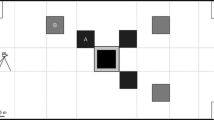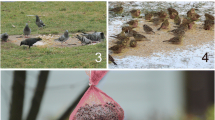Summary
Flocking behaviour of foraging Whitefronted and Bean Geese (Anser albifrons, A. fabalis) was studied in the valley of the lower River Elbe from 1994 to 1998. Geese were counted every forthnight in the winter season of 1994/95 in a study area of 170 km2, and daily in 1995/96 and 1996/97 in an area of 40 km2. In the winter of 1997/98, counts were conducted every second day. Feeding behaviour was sampled by scan sampling in 1995/96, and distances of flight reactions to an approaching car were estimated in 1996/97 and 1997/98.
Usually, geese formed large flocks. More than 90% of individuals recorded stayed in groups of more than 500 birds. In large flocks (several thousand geese), prolonged feeding times at the cost of preening and resting behaviour indicated a severe competition between individuals. Flight distances were lower in small flocks, but did not increase further with flocks becoming larger than 150 birds. As shown in earlier studies, the benefit of flocking in terms of predator avoidance is unlikely to increase any further with groups exceeding a few hundred birds.
One possible explanation of the observed flocking behaviour could be that most individuals in the population follow an opportunistic strategy when foraging. They join their foraging cnspecifics instead of looking for feeding sites on their own. Flock size was limited by population size on the one hand, and by field size on the other. Average maximum density of individuals in a flock was 0,1 birds per square meter. Thus, bird density together with field size are likely to be the main factors determining and constraining flock size on agricultural fields.
Zusammenfassung
In den Jahren 1994 bis 1998 wurden an der Unteren Mittelelbe Untersuchungen zum Aggregationsverhalten weidender Bläß- und Saatgänse durchgeführt. Mehr als 90% aller erfaßten Gänse hielten sich in Trupps auf, die aus mehr als 500 Vögeln bestanden. Eine verlängerte Freßzeit auf Kosten von Komfortverhalten und Ruhen belegte einen erhöhten Konkurrenzdruck mit zunehmender Truppgröße. Die Fluchtdistanzen kleiner Gänsegruppen war mit 60 bis 120 Metern geringer als bei größeren, doch nahmen sie bereits ab etwa 150 Vögeln bei einem Wert von ca. 200 Metern nicht weiter zu. Mit zunehmenden Bestandszahlen wuchs die Größe der „Haupttrupps“ im Gebiet, zugleich erhöhte sich jedoch auch die Anzahl der Trupps.
Eine mögliche Erklärung für die beobachtete Verteilung der Gänse auf die unterschiedlichen Truppgrößen besteht darin, daß ein großer Teil der Rastpopulation bei der Nahrungssuche opportunistisch vorgeht. Diese Gänse orientieren sich bei der Feldwahl an einigen wenigen, besonders erfolgreichen Art- bzw. Gattungsgenossen. Feldgröße und maximale Individuendichte waren wichtige Faktoren, welche die absoluten Truppgrößen auf den überwiegend aus Äckern bestehenden Nahrungsflächen begrenzten.
Similar content being viewed by others
Literatur
Altmann, J. (1973): Observational study of behaviour: sampling methods. Behaviour 49: 227–267.
Barta, Z. & Szép, T. (1995): Frequency-dependent selection on information-transfer strategies at breeding colonies: a simulation study. Behavioral Ecology 6: 308–310.
Bélanger, L. & Bédard, J. (1992): Flock composition and foraging behaviour of Greater Snow Geese (Chen caerulescens atlantica). Can. J. Zool. 70: 2410–2415.
Bergmann, H.-H. (1987): Die Biologie des Vogels. Wiesbaden.
Brunckhorst, H. (1996): Ökologie und Energetik der Pfeifente (Anas penelope L. 1758) im Schleswig-Holsteinischen Wattenmeer. Dissertation, Universität Hamburg.
Drent, R. (1980): Goose flocks and food exploitation: How to have your cake and eat it. Acta Congr. Int. Orn. Berlin 1978: 800–806.
Drent, R. & Swierstra, P. (1977): Goose flocks and food finding: field experiments with Barnacle Geese in winter. Wildfowl 28: 15–20.
Goldman, P. (1980): Flocking as a possible predator defense in dark-eyed juncos. Wilson Bull. 92: 88–95.
Hamilton, W.D. (1971): Geometry of the selfish herd. J. theor. Biol. 31: 295–311.
Holz, R. & Sellin, D. (1988): Sozialspezifische Individuenverteilung in Schwärmen von Bleßgänsen (Anser a. albifrons Scop. 1769). Ökol. Vögel (Ecol. Birds) 10: 1–11.
Immelmann, K. (1983): Einführung in die Verhaltensforschung. Berlin, Hamburg.
Krause, J. & Godin, J.-G.J. (1995): Predator preferences for attacking particular prey group sizes: consequences for predator hunting success and prey predation risk. Anim. Behav. 50: 465–473.
Krebs, J.R. & Barnard, C.J. (1980): Comments on the function of flocking in birds. Acta Congr. Int. Orn. Berlin 1978: 795–799.
Lazarus, J. (1978): Vigilance, flock size and domain of danger size in the Whitefronted Goose. Wildfowl 29: 135–145.
Lima, S.L. & Zollner, P.A. (1996): Anti-predatory vigilance and the limits to collective detection: visual and spatial separation between foragers. Behav. Ecol. Sociobiol. 38: 355–363.
McNamara, J.M. & Houston, A.I. (1992): Risk sensitive foraging: a review of the theory. Bull. Math. Biol. 54: 355–378.
Madsen, J. (1985): Impact of disturbance on field utilization of Pink-footed Geese in West Jutland, Denmark. Biol. Conserv. 33: 53–63.
Meier, M. (1996): Flächennutzung überwinternder Wildgänse (Anser spec.) an der Unteren Mittelelbe. Diplomarbeit, Universität Osnabrück.
Murton, R.K., Isaacson, A.J. & Westwood, N.J. (1971): The significance of gregarious feeding behaviour and adrenal stress in a population of Wood-pigeonsColumba palumbus. J. Zool. (London) 165: 53–84.
Naumann, J.F. (bearb. C.R. Hennicke) (18971905): Naturgeschichte der Vögel Deutschlands. Bd. 9. 360–366. Gera-Untermhaus.
Ogilvie, M. & Pearson, B. (1994): Wildfowl. London.
Ottersberg, H. (1995): Recorder 1.1 Ein Computer-programm für die Registrierung von Verhaltensweisen von Tieren. Vogelkdl. Ber. Nieders. 27: 16.
Owen, M. (1980): Wild Geese of the World. London.
Owen, M. & Black, J.M. (1989): Barnacle Goose. In: Newton, I. (ed.): Lifetime reproduction in birds. London.
Owen, M., Wells, R.L. & Black, J.M. (1992): Energy budgets of wintering Barnacle Geese: the effects of declining food resources. Orn. Scand. 23: 451–458.
Owens, N.W. (1977): Responses of wintering Brent Geese to human disturbance. Wildfowl 28: 5–14.
Raveling, D.G. (1970): Dominance relationship and agonistic behaviour of Canada geese in winter. Behaviour 37: 291–319.
Spilling, E. (1997): Witterungsabhängigkeit des Rast- und Durchzugsverhaltens von Bläß- und Saatgänsen an der Unteren Mittelelbe. Vogelkdl. Ber. Nieders. 29: 161–176.
Spilling, E. (1998): Raumnutzung überwinternder Gänse und Schwäne an der Unteren Mittelelbe: Wechselwirkung zwischen Raumbedarf und anthropogener Raumbegrenzung. Dissertation Universität Osnabrück, Göttingen.
Spilling, E. & Königstedt, D.G.W. (1995): Phänologie, Truppgrößen und Flächenwahl von Gänsen und Schwänen an der unteren Mittelelbe. Vogelwelt 116: 331–342.
Stinson, C.H. (1980): Flocking and predator avoidance: models of flocking and observations on the spatial dispersion of foraging winter shore-birds (Charadrii). Oikos 34: 35–43.
Stock, M. (1994): Auswirkung von Störreizen auf Vögel im Wattenmeer. Dissertation, Universität Osnabrück.
Urfi, A.J., Goss-Custard, J.D. & Le v. Dit Durell, S.E.A. (1996): The ability of oystercatchersHaematopus ostralegus to compensate for lost feeding time: field studies on individually marked birds. J. Appl. Ecol. 33: 973–883.
Ward, P. & Zahavi, A. (1973): The importance of certain assemblages of birds as „information-centres“ for food-finding. Ibis 115: 517–534.
Author information
Authors and Affiliations
Rights and permissions
About this article
Cite this article
Spilling, E., Bergmann, HH. & Meier, M. Truppgrößen bei weidenden Bläß- und Saatgänsen(Anser albifrons, A. fabalis) an der Unteren Mittelelbe und ihr Einfluß auf Fluchtdistanz und Zeitbudget. J Ornithol 140, 325–334 (1999). https://doi.org/10.1007/BF01651029
Accepted:
Published:
Issue Date:
DOI: https://doi.org/10.1007/BF01651029




